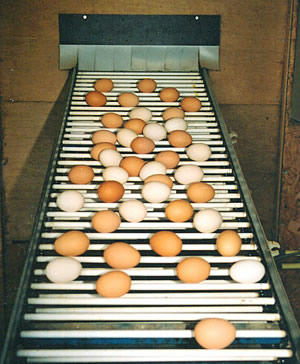
Eggs were never designed to be eaten! Their role is clearly to act as a vehicle to carry a developing embryo, protected against the outside elements but able to ’breathe’ during that development and get rid of unwanted waste products at the same time. This requires a strong rigid shell of the right thickness with the right number of pores (holes) to allow movement of gases and just the right amount of water. The hen couldn’t care less what colour egg she lays...sadly consumers are not so obliging.
Having welcomed the recent early Summer weather and bright sunshine to encourage ranging, as well as generally making everyone a little more cheerful, that enthusiasm has been tempered by the annual head scratching related to the ’white egg syndrome’.
We have discussed previously in the Ranger all the possible disease, parasite and nutritional causes of poor shell colour. But each year we keep coming back to cases where none of the usual suspects fit and we are left with sunshine as the prime candidate.
The colour of an egg shell is due to laying down of pigment in or just under the cuticle. The process takes place in the shell gland where the egg spends the last 20 hours of its journey down the oviduct. The process of adding pigment to the shell occurs as one of the last processes to producing the completed egg.
Various theories have developed usually relating to the experiences and anecdotes of many producers. It is certainly a problem associated with free range, usually with eggs that are perfectly formed in every other way, mostly out of hens showing no clinical signs of illness and sometimes associated with feather loss. The most consistent finding in this syndrome is the reversion to normal shell colour when the flock is kept indoors and further episodes when the birds are let out again.
To date, no convincing explanations have come forward. As indicated above, the problem does not seem to relate to any specific infectious cause. A number of viruses such as infectious bronchitis (IB) can affect shell colour but are usually accompanied by other shell abnormalities. Avian pneumovirus (TRT) infection has certainly been associated with pale egg problems but does not help to explain the curative effect of re-housing a flock.
The coincidental finding of poor feathering with the condition may merely suggest that ’stress’ is a contributing factor but it is a true case of chicken or egg in trying to work out what is cause or effect with feather pecking. So another year has gone past and the problem has not been ’cracked’.
Where do we go from here?
I suspect any solutions will be a combination of an eagle eyed producer working with researchers but where should we all be looking?
What about factors which affect the laying down of pigment? White shelled eggs certainly have far less pigment in the cuticle. Pigment is usually incorporated just before the eggs are laid, so does sudden exposure to sunlight lead to eggs being laid maybe an hour or two early before the pigment gets a chance to be included? Worth looking into although it is difficult to know how we could cure that anyway.
Another factor is trying to find out if direct sunlight on the hens’ body (remember it may be worse in hens with poor feather cover) can interfere with the process.
As far as we are aware, there are no light sensitive cells in the oviduct and it is difficult to believe that sunlight could penetrate the birds’ body that deeply anyway. It is known that the body clock of birds, sheep and probably other mammals, including man, is related to sunlight penetrating the skull and having a direct effect on a sensitive area in the brain, the pineal gland. Maybe sunlight is triggering an area of the brain directly to influence hormone release. It may be an interesting idea to see hens on range wearing balaclavas to test that hypothesis!
This rather light hearted consideration of what can be a financially serious problem for producers exposes a fascinating, if frustrating, phenomenon. For once the vets are not blaming disease or nutrition! There is a need for some lateral thinking and, unfortunately, some money targeted at some specific research into this puzzling problem.
